What's inside
Whether the goal is muscle growth, strength, or endurance, most workout programs are based on foundational movement patterns.
One of these important movements is horizontal pressing. This is where we’re pushing the upper limbs in front of the body.
This movement pattern is important for many functional activities and involves many of the target muscles people want to improve in the gym.
If you want to get stronger, increase mobility, and more, keep reading. This article is a straightforward yet comprehensive guide to horizontal press exercises.
We’ll explore how horizontal pressing works and which muscles it uses. From there, you’ll learn the best horizontal push exercises for strength, muscle, and function in this range of motion.
Understanding the Basic Movement Patterns

Horizontal pressing is one of several fundamental movement patterns that make up our daily activities, in the gym, during sports, or just in everyday life.
These basic movements include pressing (or pushing), pulling, squatting, hinging, and twisting.
These are large, multi-joint movements involved in every basic task we do.
For example, think of a standard morning routine.
To sit up in bed is a hip hinge assisted by a push. To turn and stand up off the bed is a twist and squat, and to open the bedroom door is a pull.
Certain movements like the push or press can be further broken down into vertical or horizontal pressing.
A vertical push involves movements in which we press the arms overhead, while horizontal pressing is when we push the arms in front of the body.
What are horizontal exercises?
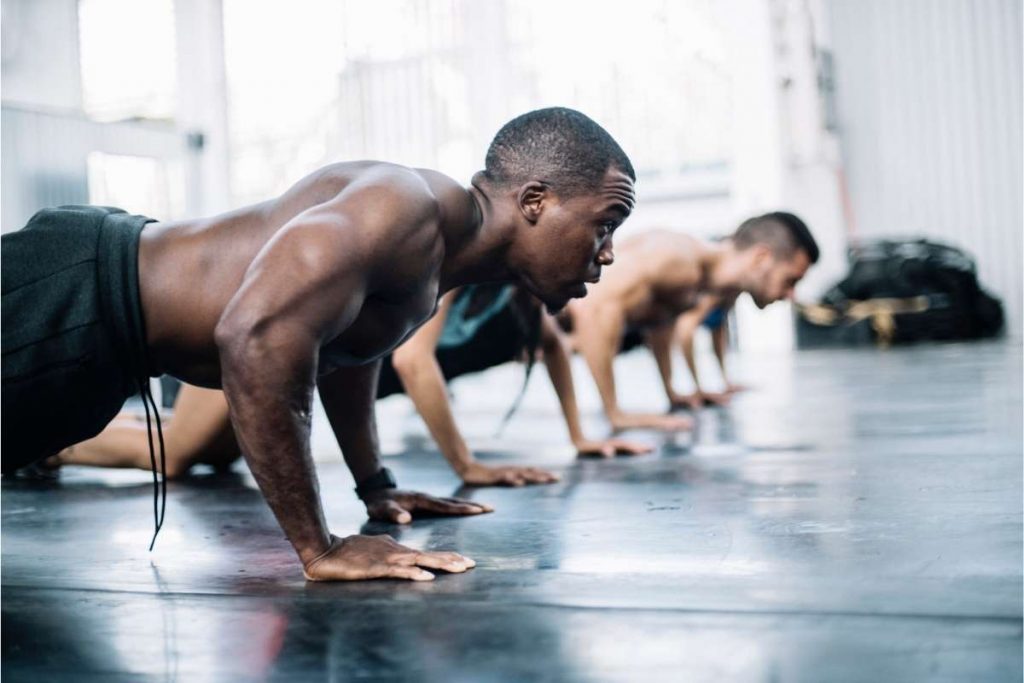
Horizontal pressing movements consist of certain joint movements of the upper limb.
These are shoulder flexion or horizontal abduction, combined with elbow extension to push the arms out in front of the body.
The opposite movements – shoulder extension or horizontal adduction as well as elbow flexion, bring the limbs back to a neutral position.
The shoulder blades also play a big role in horizontal pushing exercises, as they protract to push the arms further forward, and retract to bring them back.
Horizontal press exercises can be open or closed-kinetic chain movements. This is where the push is done to move the body, or an external weight or object.
For example, a push-up is a closed-chain horizontal push, with the hands anchored and the body moving through space.
A bench press, on the other hand, is an open-chain horizontal press, with the body secure on the bench while the arms push the bar upward.
Muscles Worked in Horizontal Push Exercises
Pectorals
The pectoralis major is what’s known as the prime mover in horizontal pressing. This means it’s the muscle that performs the majority of the work in the movement.
The pecs run from the sternum and collar bone to the front of the upper arm. They horizontally abduct, flex, and adduct the shoulder joint.
Triceps
The triceps brachii is a three-headed muscle that extends the elbow, completing many horizontal pushing exercises.
This muscle runs from the back of the shoulder (and shoulder blade) down to the forearm, making it a multi-joint spanning muscle.
Anterior Deltoids
The anterior head of the deltoid muscle is another synergist muscle in horizontal pressing.
This portion of the shoulder is responsible for flexion at the shoulder joint and assists the pecs in moving the upper limb in front of the body.
Serratus Anterior
The serratus anterior is an often overlooked, but critical, muscle in horizontal push exercises.
This muscle runs from the sides of the ribs into the inner part of the shoulder blades, helping to pull them around the rib cage to further extend the arm forward.
How To Do Horizontal Push Exercises at Home
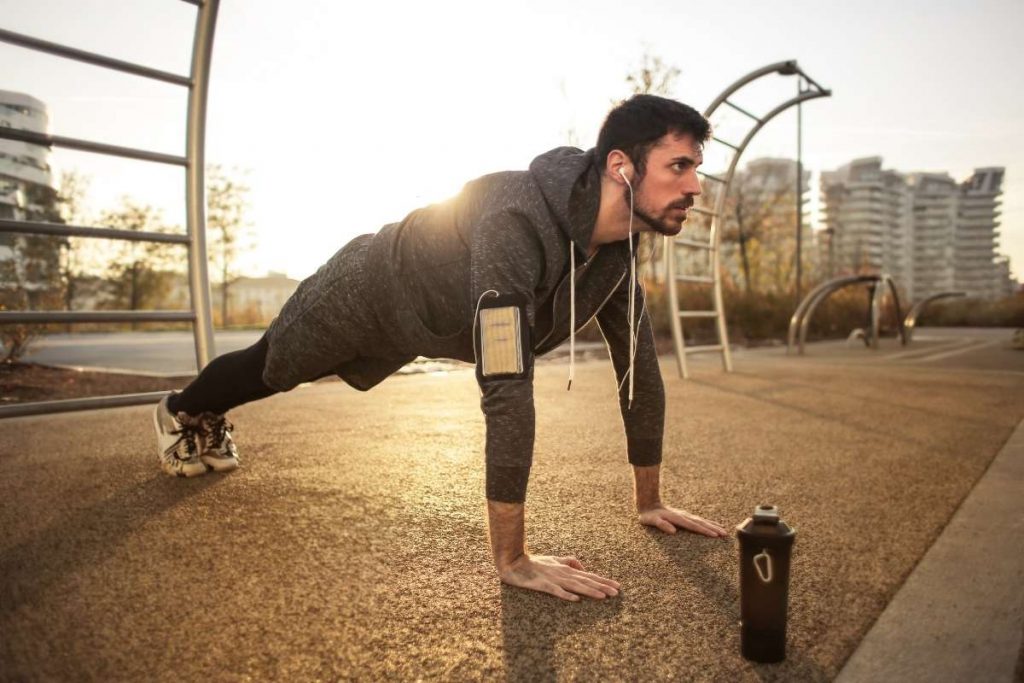
As mentioned, horizontal pushing is a basic movement pattern that is done not only while training but in everyday activities.
Even with no specialized equipment, you can do many horizontal push exercises at home.
One of the best options is the push-up, which has variations for any fitness level.
Here is a list of push-up variations which can be done at home:
- Wall push-up
- Bench push-up
- Knee push-up
- Full push-up
- Close-grip push-up
- Decline/elevated push-up
- Depth push-up
- Spider-man push-up
- Diamond push-up
- Typewriter push-up
- Planche push-up
- Fist push-up
- Finger push-up
- One-arm push-up
As you can see, there are options for complete beginners as well as the most advanced calisthenics athletes.
Add in a few pieces of basic home fitness equipment like a pair of dumbbells, resistance bands, and a bench, and you have even more options for horizontal pressing at home.
The 5 Best Horizontal Push Exercises
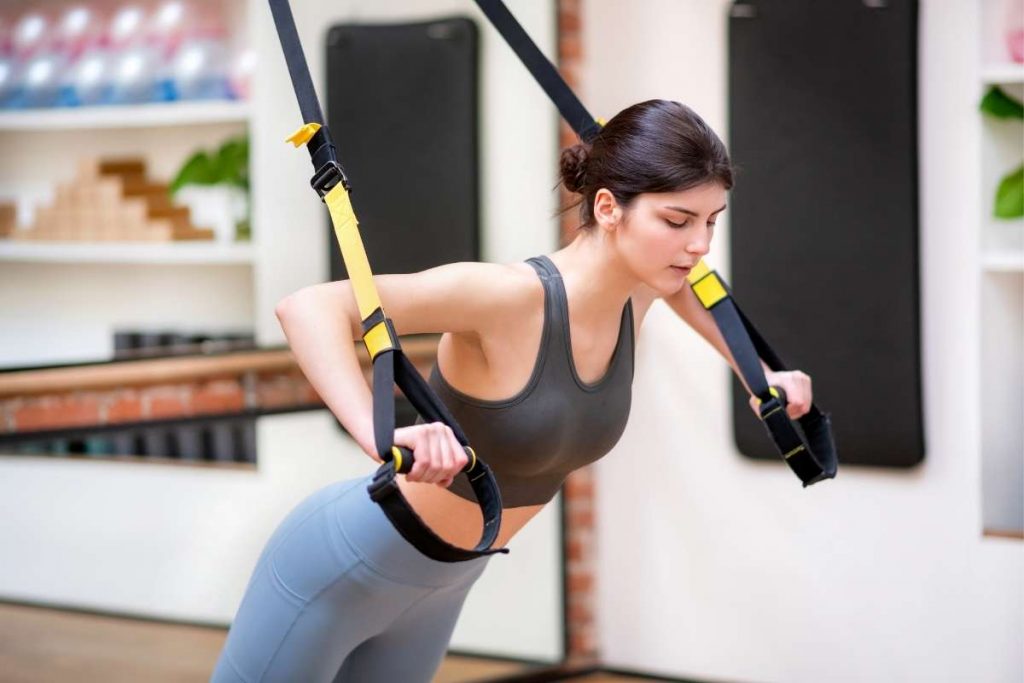
Horizontal pushing exercises all follow the fundamentals of the movement pattern of pressing the upper limb in front of the torso.
The following exercise examples all follow this rule while switching up equipment and techniques to vary the core movement.
For example, there are open and closed-chain variations, plus exercises working against gravity in different directions.
There are also different equipment options that allow the focus to be placed on different fibers of the muscles.
1. Push-Up
The push-up is the core horizontal pushing movement to move our body through space.
Not only for military boot camp or football training, the push-up is necessary for things as simple as getting up off the ground after a fall.
For a horizontal push exercise that can be done anywhere, anytime, go with the humble push-up!
Equipment Requirements: Push-up handles (optional), wall/bench (variations), suspension handles (variation)
How to Perform Push-Up:
- Lie face down with the legs straight and hands on either side of the chest
- Squeeze the shoulder blades together and brace the entire body
- Keeping a straight line from the shoulders through to the ankles, push off the ground
- Breathe out as you push up, and pull the tummy in strong
- Give an extra push at the top to engage the serratus before slowly lowering down
Benefits: Can be done anywhere, closed-chain movement, strengthens serratus anterior
Pro Tips: Once you can comfortably do 15-20 repetitions of whatever variation you’re doing, be sure to progress to a more challenging version.
2. Bench Press
If the push-up is the king of closed-chain horizontal push exercises, the bench press is undoubtedly the king of the open-chain press.
While the barbell bench press provides a great balance of semi-stability with heavy weight, this movement can be done using different equipment as well.
The dumbbell bench press provides a little more freedom of movement but requires more stabilization.
A machine chest press provides more stability but limits the plane of movement somewhat.
The basic bench press can also be modified in terms of grip width for more chest, shoulder, or tricep activation, as well as different angles for the various heads of the pectoral muscle.
Whichever version you choose, performing a horizontal press exercise using progressively heavier weight will build strength and size in the target muscles.
Equipment Requirements: Bench, barbell, plates, safety clips, rack, dumbbells, or machine (variations)
How to Perform Bench Press:
- Lie on the bench with the eyes under the bar and hands at a comfortable width
- Plant the heels, squeeze the glutes and arch the back slightly while squeezing the shoulder blades together
- Unrack the bar and inhale as you slowly lower it to the chest at the nipple line
- Squeeze the bar hard and breathe out as you press the bar straight up over the chest
Benefits: Basic bilateral horizontal press, builds strength in all target muscles, room for progression
Pro Tips: Experiment with grip width and body position in a way that allows you to get good activation from the chest, shoulders, and triceps.
3. Standing Plate Press
This exercise, also known as the Svend press, adds a different twist to the horizontal pressing movement.
The plate press involves pushing the weight out in front of you while in an upright position.
This means that although the movement pattern looks the same, gravity is working differently.
The weight will be getting pushed downward, requiring more recruitment from the anterior delts and upper chest to keep the arms level.
Add this exercise to your routine if you want to build a shelf-like upper chest and resilient shoulder strength.
Equipment Requirements: Plates, dumbbell (home variation), bench (optional)
How to Perform Standing Plate Press:
- Sit or stand holding the weight in front of the chest
- Hold the weight by squeezing the palms together, rather than by propping up with the hands
- Keep a neutral spine as you press the weight directly in front of the chest
- Hold in the extended position, then slowly return to the starting position
Benefits: Focuses on upper chest and anterior delts, provides a challenge without heavy weight
Pro Tips: Think of squeezing the palms and elbows toward each other for a brutal chest contraction during this exercise.
4. Coffin Press
This next horizontal press is great for those who want to develop their inner chest area.
The coffin press is done by pressing two dumbbells together and pressing from a lying position.
This provides a greater range of motion for elbow extension, biasing the triceps in addition to the inner pecs.
Alternatively, you can do the plate press above, just from a lying position.
Equipment Requirements: Dumbbells, bench, plates (variation)
How to Perform Coffin Press:
- Lie on a bench, holding two dumbbells together on the chest
- Squeeze the shoulder blades back and flare the elbows out slightly
- Actively press the weights together while pushing them up off the chest
- Slowly reverse back to the starting position and repeat
Benefits: Builds inner portion of pec muscles, greater ROM for triceps
Pro Tips: Again, try to push the elbows close together at the top for a strong chest contraction in the shortened position.
5. Cable Press
Finally, we have another way to provide a different stimulus while performing a horizontal push exercise.
Cable presses provide consistent resistance while emphasizing different angles, depending on your goals.
For those at home, resistance bands can provide a similar effect, just with a different strength curve.
The bands will provide more resistance the further out you press, which can be great for strengthening that final “plus” press with the serratus muscles.
Equipment Requirements: Cable machine, handles, resistance bands (variation)
How to Perform Cable Press:
- Stand in the center of the machine with the cables at the desired height
- Hold the handles close to the armpits with one foot forward
- Brace the core and plant the feet as you press the handles forward
- Squeeze the chest as you bring the handles together, and control back
Benefits: Smooth resistance curve, allows greater shoulder adduction toward midline
Pro Tips: Experiment with turning the palms upward in the middle to feel a greater squeeze in the inner and lower chest.
Horizontal Push Workout Program
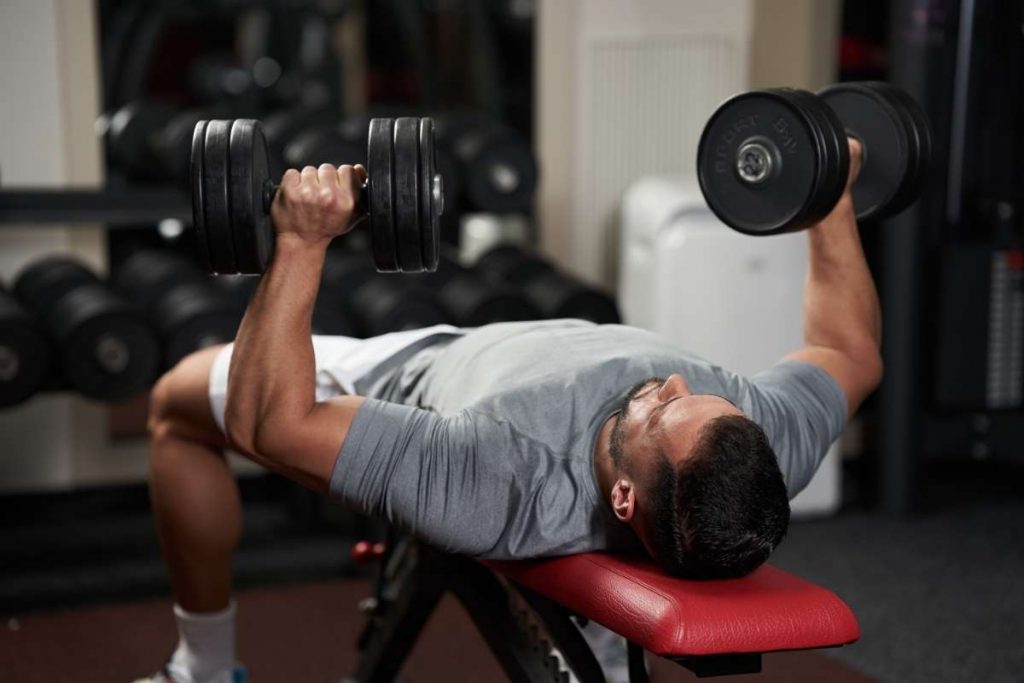
The following workouts include some of the best variations of the horizontal push exercises listed above.
The beginner program is three exercises performed as a complete horizontal push workout, or as part of a bigger push day.
The advanced workout covers all aspects of horizontal pressing for the more experienced lifter.
It includes moves for heavy strength work, bodyweight control, and specific focus for various sections of the chest muscles.
This workout can also be complemented with additional vertical pressing or isolation work.
Here are a couple of examples of a weekly schedule to fit your horizontal push workout into:
Weekly Schedule: PPL
- Monday: Horizontal Push
- Tuesday: Vertical Pull
- Wednesday: Squat Legs
- Thursday: Vertical Push
- Friday: Horizontal Pull
- Saturday: Hinge Legs
- Sunday: Rest
Weekly Schedule: Upper/Lower
- Monday: Horizontal Push + additional upper body exercises
- Tuesday: Lower Body
- Wednesday: Rest
Thursday: Horizontal Push + additional upper body exercises
- Friday: Lower Body
- Saturday: Rest
- Sunday: Rest
Horizontal Push Exercises for Beginners
| Exercise | Sets x Reps | Rest |
| Dumbbell bench press | 3×8-12 | 2-3 min |
| DB svend press | 3×10-12 | 1-2 min |
| Close-grip push-up | 3xMAX-1 | 1-2 min |
Advanced Horizontal Push Exercises
| Exercise | Sets x Reps | Rest |
| Bench press | 4×5-8 | 3-5 min |
| Suspension push-up | 3xMAX | 2-3 min |
| Coffin press | 3×12-15 | 1-2 min |
| Standing low cable press | 3×10-12 | 1-2 min |
Tips for Performing Horizontal Push Exercises Effectively
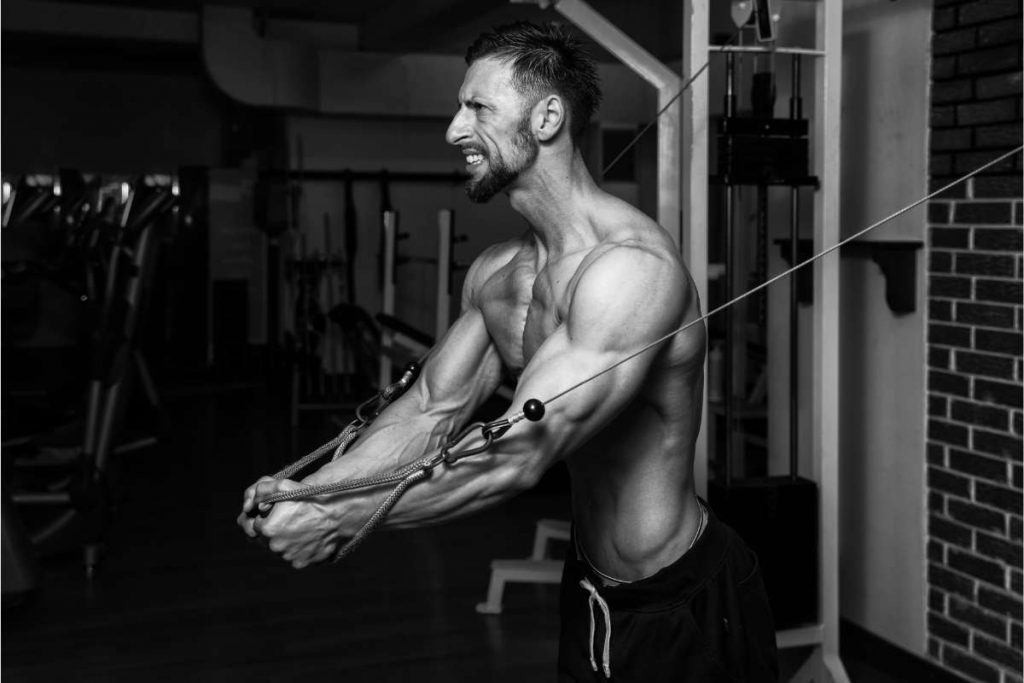
Connect With the Pushing Muscles
During any of the exercises listed above (or their variations), it’s important to make sure that the target muscles are doing the work.
Take the time to study the muscle groups involved, where they are, and how they move the joints and limbs.
Then, you can practice the exercises while making sure you can feel the pecs, shoulders, and triceps contracting properly.
Full-Body Awareness
While you pay attention to the horizontal pushing muscles working, you should also be aware of what the rest of the body is doing.
In large, compound movements, there are a lot of moving parts, and the body often tries to compensate when heavier weights are involved.
Whether it’s a push-up, cable press, or Svend press, make sure the entire body is stable while performing the movement with the upper limb.
Provide Balanced Programming
As you strengthen your pushing movements, you must train the opposing muscles and movements as well.
Neglecting antagonist muscle groups that perform the countermovements can lead to muscle imbalances, poor posture, and even pain or injury.
Perform horizontal pulling exercises like cable rows, inverted rows, and one-arm rows to counteract your pushing workouts.
These moves may be performed during the same workout or in a different session, depending on which training split you’re using.
Frequently Asked Questions
What are some horizontal push exercises?
The basic horizontal pushing patterns listed in this article are the push-up, bench press, Svend press, coffin press, and cable press.
Within these five exercises are dozens of additional variations. Everyone can find something to suit different sub-goals within the scope of horizontal pushing movements.
What is an example of a horizontal push?
This article covers the main types of horizontal push exercises, the main two types being open and closed-chain movements.
An example of a closed kinetic chain horizontal push is the push-up, and an open-chain example is any chest press with an external weight, like the bench press.
What are 5 pushing exercises?
In addition to the five horizontal pushing exercise types above, there are a range of vertical and angled pushing movements.
Five examples include the shoulder or overhead press, incline bench press, dips, decline press, and the Arnold press.
Closing Comments
So, what do you think of our guide to horizontal push exercises?
We hope you got some new insight into this fundamental movement pattern and found a useful tip or two to add to your training.
As we learned, working on horizontal push movements isn’t just good for muscle mass. It helps you perform everyday movements more safely and efficiently.
Let us know your favorite horizontal press exercises and tips in the comments. If you have any friends just starting training, share this info with them as well.

